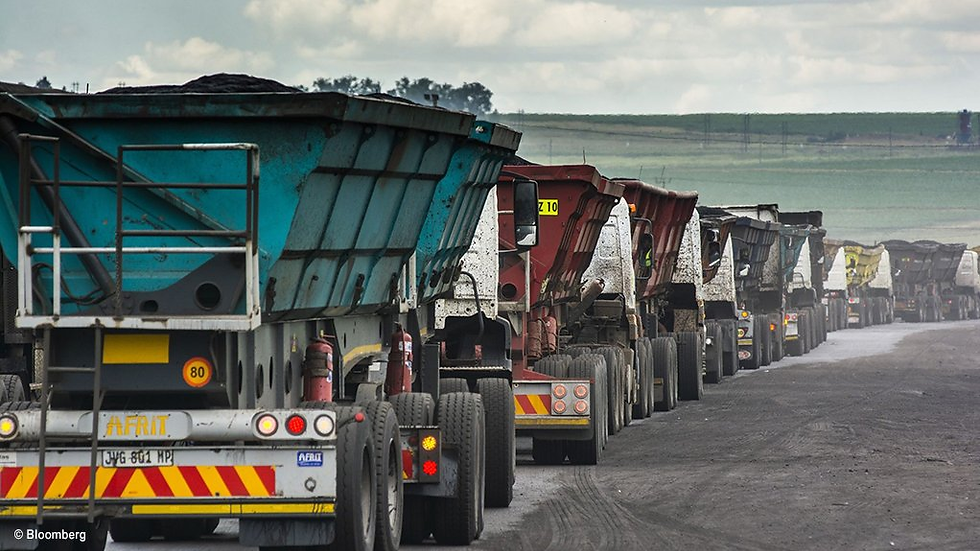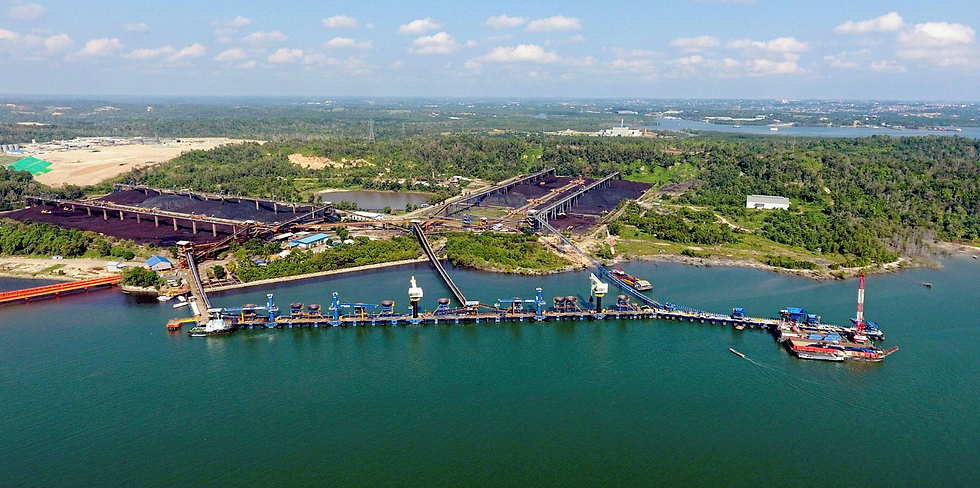World Coal Market Overview: Key Developments as of November 1, 2024
- Brandcodax
- Nov 4, 2024
- 7 min read

The global coal market showed mixed trends in early November 2024, with European thermal coal prices holding steady at around $119-122 per ton, supported by high natural gas costs and colder weather. In Europe, increased demand for coal and gas-fired generation boosted power prices, while reduced renewable output shifted the energy mix. South African coal prices were stable, though trading slowed in anticipation of Indian holidays. Meanwhile, Australia’s coal prices rose due to terminal maintenance, and China saw stable prices amid limited demand. This overview highlights key trends and factors shaping coal markets worldwide, offering insights into shifting energy needs and regional impacts.
European Thermal Coal Prices Steady Amid Cold Snap Forecast

European thermal coal prices held steady between $119-$122 per ton this week, buoyed by persistently high natural gas costs and the forecast of colder temperatures across the continent. With increased demand for reliable power sources, coal-fired generation in Europe saw a significant boost as renewable energy output declined. In Germany, electricity prices jumped to €113.15/MWh from €84.97/MWh last week, largely due to lower renewable energy contributions, which dropped from 62% to 53% of the energy mix. This shift increased fossil fuels’ share to 47%, highlighting the flexibility of coal in stabilizing supply during high-demand periods. Across the continent, utilities continued turning to coal to ensure stability in the face of fluctuating wind and solar outputs. This ongoing trend of the global coal market illustrates the reliance on coal as a balancing force, especially in regions where renewables alone cannot meet seasonal energy needs. The steady coal prices and shifts in energy sources emphasize the impact of weather patterns and resource availability on energy strategies and pricing.
Natural Gas Price Adjustments and Impact on Coal

Natural gas quotations at the TTF hub slightly decreased to $459.66 per 1,000 cubic meters, marking a modest weekly decline that could signal broader impacts on the coal market. Despite the decrease in the global market, Goldman Sachs has indicated that prices might continue to drop if Europe maintains a steady flow of Russian gas imports, potentially softening the demand for coal as a backup energy source. With coal stocks at Amsterdam-Rotterdam-Antwerp (ARA) terminals rising to 4.1 million tons (an increase of 0.28 million tons), Europe appears well-prepared to meet winter demand. This stockpile increase is significant, ensuring sufficient resources if gas prices become volatile or colder-than-expected weather boosts coal requirements. Additionally, high stock levels offer stability for coal prices in the coming months, as they balance against shifts in natural gas prices. The interplay between gas prices and coal demand remains critical; any prolonged natural gas price adjustments could continue shaping coal’s role in Europe’s energy mix, especially as regions rely on these resources to stabilize electricity costs and secure heating needs.
South African Coal Market Update

South African High-CV 6,000 coal prices remained steady at $110 per ton, with stable demand and limited export activity shaping recent market trends. The Indian market, a key destination for South African coal, experienced slower trading activity as buyers paused purchases ahead of the Diwali holiday on October 31. This temporary reduction in demand from Indian sponge iron producers reflected a cautious approach, with many choosing to assess market dynamics before committing to new orders, particularly with an eye on potential January purchases. The situation was compounded by Cyclone Dana, which disrupted operations at critical Indian ports, including Dharma, Paradip, and Haldia. The cyclone impacted coal logistics, as heavy rainfall and strong winds led to delays in unloading and cargo handling. Consequently, the holiday season and logistical challenges have added to the complexity of coal trade between South Africa and India, affecting both supply chains and short-term pricing stability, while producers and buyers alike monitor evolving market conditions to inform upcoming decisions.
Richards Bay Stock Levels and Export Trends

The Richards Bay Coal Terminal (RBCT) recently reported stockpile levels of 3.96 million tons, marking the highest levels since 2021. This increase reflects a combination of steady inflows and moderated export activity, as regional factors influenced the movement of coal shipments. Despite this peak, weekly export shipments dropped by 30% to 0.83 million tons, a decline from the 2024 weekly average of 0.95 million tons. This reduction in exports may be attributed to a slowdown in demand from key markets such as India and Asia, where the recent festive season temporarily decreased purchasing volumes. Additionally, logistical challenges, including rail disruptions and maintenance schedules, have affected the terminal’s shipping efficiency, further impacting export rates. For stakeholders, these export trends highlight the importance of flexible inventory strategies and the need to address infrastructure gaps to support consistent, reliable shipment levels. As global coal demand fluctuates, RBCT’s stock levels and export capabilities continue to play a critical role in meeting the energy needs of international markets.
Chinese Coal Prices and Power Plant Demand

Chinese 5,500 NAR spot prices held firm at $120 per ton, influenced by production caps on smaller mining operations that limited overall supply. This price stability came as coal consumption at coastal power plants increased, rising from 1.87 to 1.93 million tons per day. Although demand grew, forecasts indicating that temperatures will remain above seasonal averages until November 5 mean coal usage for heating is unlikely to surge significantly. The recent completion of maintenance on the Daqin rail line has improved coal transportation efficiency, allowing higher daily deliveries to coastal ports, a factor supporting ample stockpiles. Currently, inventories at China's six largest coastal power plants have slightly decreased to 14.72 million tons (down by 0.15 million tons), while coal stocks at key ports have risen to 25.63 million tons (an increase of 0.58 million tons). These ample supplies at ports and power plants provide a stable buffer to meet energy demands, potentially keeping coal prices steady amid moderated consumption rates and sufficient logistical support.
Indonesia’s Coal Quotations Amid Limited Demand

Indonesia’s coal market faced marginal adjustments as prices responded to limited demand and strategic supply management. The 5,900 GAR coal corrected slightly, reaching $93.6 per ton, down by $0.20 from the previous week, while the 4,200 GAR held steady at $52.3 per ton. This stability largely stems from sufficient stock levels among consumers, reducing the need for spot purchases and softening demand pressure. Exporters are also moderating supply to prevent excess inventory that could lead to price drops, especially as they approach year-end sales. These efforts reflect Indonesia’s cautious market strategy, aimed at balancing supply with relatively muted demand. By prioritizing supply control, exporters seek to maintain price stability in a competitive landscape, even as other global coal markets see varying price trends. This approach underscores Indonesia’s adaptability, ensuring that coal pricing aligns closely with demand while supporting consistent value for both suppliers and buyers in the short term.
Australian Coal Prices and Cyclone Season Preparations

Australian High-CV 6,000 prices have surged past $145 per ton, reflecting both increased demand and anticipation of cyclone season disruptions, a recurring factor that affects coal export logistics. Major terminals such as Abbot Point, PWCS, and Hay Point are actively conducting maintenance on shiploaders and berths to mitigate potential delays in the coming months, ensuring readiness for possible weather impacts. Meanwhile, metallurgical coal prices climbed to $205 per ton as Chinese steelmakers ramp up production, buoyed by improved profit margins following a subdued September. This resurgence in Chinese output is particularly notable, as China relies on Australia’s premium metallurgical coal to meet its high-quality production standards. In a significant development, Glencore’s 113% production boost, largely driven by its acquisition of Elk Valley Resources, has bolstered global supply and helped stabilize the market. This proactive approach from Australian exporters, coupled with steady supply from major producers, underscores Australia’s pivotal role in meeting global coal demands and supporting supply stability during a volatile season.
A Diverse Coal Market with Stable Price Trends
The global coal market remains dynamic as seasonal demand and strategic adjustments in production and exports continue to influence regional prices. European coal prices remain bolstered by natural gas costs and weather-driven demand, while South Africa and Australia navigate logistical and seasonal maintenance concerns. In Asia, China and India’s demand and inventory trends are poised to shape market directions heading into the year-end. The supply chain adjustments, stock levels, and price management efforts across regions reflect the coal market’s adaptive response to geopolitical, seasonal, and demand-driven factors. Going forward, continued monitoring of stockpile levels, renewable output, and regional demand trends will be crucial to understanding coal’s evolving role in the energy landscape.
Frequently Asked Questions
Q1. Why did European thermal coal prices increase recently?
European thermal coal prices saw an increase due to high natural gas prices, combined with forecasts for colder November weather. With gas becoming more expensive, coal and gas-fired power generation in Europe rose, partially due to decreased renewable energy production caused by lower wind and solar output. This shift pushed electricity costs up in Germany as fossil fuel reliance grew. Additionally, colder weather in Europe prompted higher energy demands, which in turn increased coal usage, adding further upward pressure on coal prices across European markets.
Q2. How are Indian holidays affecting South African coal trade?
The upcoming Festival of Lights in India has led to a pause in coal trading activity, with Indian sponge iron producers delaying purchases until after the celebrations. This temporary slowdown has impacted demand for South African high-CV coal, which is a key source for Indian industries. Additionally, recent cyclone-related disruptions at Indian ports have affected coal imports, contributing to a cautious market. As Indian buyers await clearer post-holiday market signals, South African coal traders are noticing a temporary dip in export activity, which may rebound in the following weeks.
Q3. What are the factors impacting coal demand in China?
In China, coal demand is influenced by weather, production quotas, and ongoing rail maintenance. A warmer-than-average November forecast has limited coal consumption, although a recent rise in power generation in coastal provinces has slightly increased demand. Many smaller Chinese producers temporarily paused operations after reaching their monthly output limits, tightening local supply. Meanwhile, completed maintenance on the Daqin rail line is improving coal stockpiles at ports, contributing to supply stability. However, some industry analysts predict price softening as high port inventories balance with moderate, weather-dependent demand.
Q4. Why are Indonesian coal prices relatively stable?
Indonesian coal prices have stayed steady due to reduced buying interest, as many buyers hold large stockpiles and aren’t actively seeking new supplies. This has placed slight downward pressure on the 5,900 GAR coal prices, though sellers are not significantly lowering prices to maintain market stability. Additionally, with year-end approaching, many Indonesian exporters are avoiding overproduction to prevent excess supply, which would drive prices down. This market balancing by both buyers and sellers keeps the Indonesian coal prices stable for now, even as other regions experience more fluctuation.
Q5. How is Australian coal production preparing for cyclone season?
In anticipation of the cyclone season, Australian coal terminals are undergoing maintenance to ensure safe and efficient operations. Shiploader and berth maintenance work is taking place at major terminals, including Abbot Point, Hay Point, and PWCS, from late October through early November. These preparations are crucial for minimizing disruptions once cyclone season begins, as the coal export infrastructure along Australia’s eastern coast is highly exposed to severe weather impacts. The current maintenance efforts also support steady coal prices, as production and exports are expected to resume without significant delays post-maintenance.

